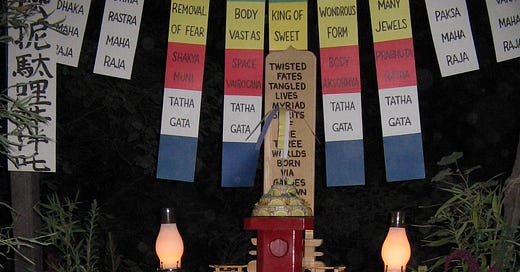Zen in Ten: Hungry Ghosts Hanging Upside Down
Obon Ceremony Honors the Spirits of Deceased Ancestors
Until I spent a full year at Tassajara Zen Mountain Center, I never heard of Obon, one of the most important ceremonies in Japanese culture and the Buddhist tradition. This is one of the few ceremonies at Tassajara that the guests participate in with the residents.
“The Obon, or Bon, festivals of Japan are held in mid-July in some parts of Japan and mid-August in other parts. The three-day festival honors departed loved ones and loosely correlates to Hungry Ghost festivals held in other parts of Asia.” 1
“The term Obon is the shortened version of Urabon-e, or Ullambana, a Sanksrit word meaning ‘to hang upside down.’ Because the suffering in the realm of the hungry ghosts is like the pain of hanging upside down, this ceremony is called Ullabana.”2
“Obon is one of the most important holidays in Buddhism. The summer festival of Obon honors the spirits of deceased ancestors. It is a time to make offerings to family members, friends, and even pets who’ve passed away, as well as to spirits who have no one left to honor and remember them. These spirits are called ‘hungry ghosts.’ ”3
“A chant named Kanromon is chanted; offerings of rice, water, and vegetables are placed on the altar. All the doors and windows of the temple are opened so that the spirits can enter, eat, and return back to their place in the six realms, having been sustained by the offerings. The merit of the chanting and offerings made to the buddhas and bodhisattvas is transferred to these spirits that they may find their way to buddhahood.”4
“The story of Obon says that when Mokuren, or Maudgalyana in Sanskrit, a disciple of the Buddha, was sitting in meditation, he saw a vision of his deceased mother as a hungry ghost wandering in search of food. When she was able to find some and tried to eat it, it turned to fire in her mouth before she could swallow it. When she found water, it turned to pus.”5
“Maudgalyana told Buddha of his vision, saying how tormented he was by his mother’s suffering. The Buddha then instructed Maudgalyana to make offerings to the other monks in the sangha and transfer the merit to his suffering mother. Maudgalyana did this, and then later he had a vision that his mother’s karma had been exhausted, and her time in the realm of hungry ghosts had ended. Maudgalyana was so happy that he began to dance.”6
“Bon odori (folk dance) is the most common custom of Obon, and anyone can participate. Bon dances usually are performed in a circle. People dance through the streets to the music of flutes, drums, and bells, singing, ‘It's a fool who dances and a fool who watches; if both are fools, you might as well dance!’"7
“There are many cases in which the movements of the dances passed down from long ago are made to coordinate with lyrics describing such actions as ‘harvesting the rice’ or ‘scooping the mud.’ ”8
“Obon begins with the so-called mukaebi practice (welcoming fires), during which people make a small bonfire in front of their houses to guide spirits upon their return back home. Decorating the deceased’s altar with small memorial tablets, fruits, flowers, and Japanese sweets is also part of the early preparation stage—a practice used to offer late loved one’s objects they enjoyed in their lifetime. While practiced mostly in countryside areas recently, some regions will also prepare horses made of cucumbers and cows made of eggplants with wooden sticks for legs. The symbolism behind it is that the horse will help spirits return home as soon as possible, while the cow will take them back to heaven slowly as soon as the festival is over.”9
“On the third day of the festival, paper lanterns—sometimes by the hundreds or thousands—are set afloat in lakes, rivers, and even the ocean to guide the spirits back to their resting places. On the fourth day, families return to the burial sites to tidy the graves and say goodbye to their ancestors until they meet again the next year.”10
O'Brien, Barbara. "Buddhist Holidays, 2019–2020." Learn Religions, Sep. 5, 2021, learnreligions.com/buddhist-holidays-449918.
Amato, Seigaku. The Complete Illustrated Guide to Zen. Somerville, MA, Wisdom Publications, 2021.
Ibid.
Ibid.
Ibid.
Ibid.
O'Brien, Barbara.
https://www.inhamamatsu.com/culture/bon-odori.php
https://savvytokyo.com/obon-the-japanese-festival-of-the-dead/
https://tricycle.org/beginners/buddhism/obon/





